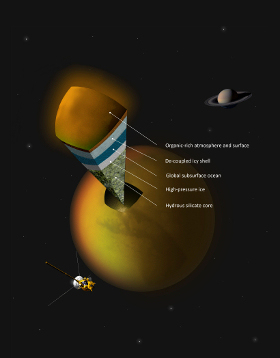Science highlights from Huygens:
#5. Radioactive decay and cryovolcanism
Radiogenic argon was detected by the GCMS below 18 km. This detection was important because 40Ar originates solely from the decay of potassium-40 (40K), a radioactive isotope of potassium found in rocks. The only possible source of this 40Ar is rocks which exist deep in Titan's interior, below the satellite's mantle of hydrocarbon and water ice.
Since the radioactive half-life of 40K is about 1.3 billion years, much shorter than the lifetime of Titan, the small amount of 40Ar in the atmosphere provides an important indicator of how much outgassing has occurred from the deep interior.
 |
| Concept sketch of the interior of Titan. Credit: Angelo Tavani |
If the rocky component of Titan's interior has the same composition as that of the Earth and has outgassed to the same extent, 40Ar should be about ten times more abundant than measured by Huygens, comprising approximately 0.05% of the atmosphere.
If the interior was warm enough in the past for a liquid water or water-ammonia mantle to have reached all the way down to the moon's rocky core, potassium could have seeped into the liquid. The radiogenic 40Ar could then have outgassed to the surface.
Certainly, the presence of the 40Ar at the levels seen by Huygens is a strong indication of geological activity on Titan, and consistent with periodic replenishment of atmospheric methane (see science highlight 3: Methane mystery). The apparent evidence for cryovolcanism observed by the Cassini orbiter – involving water or a mixture of water and ammonia – provides one possible process for release of both gases from the interior.




